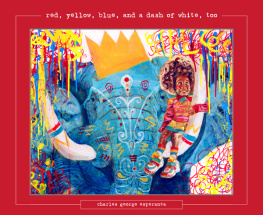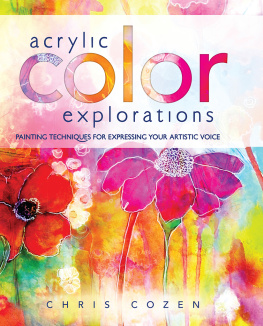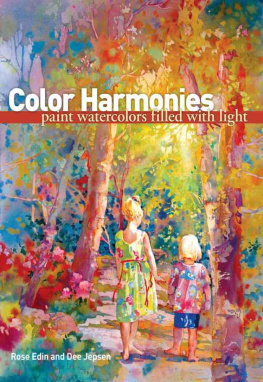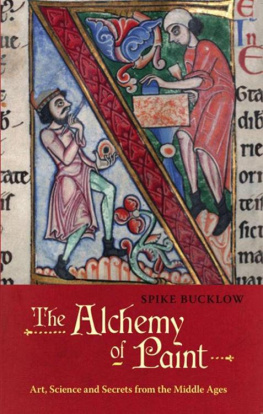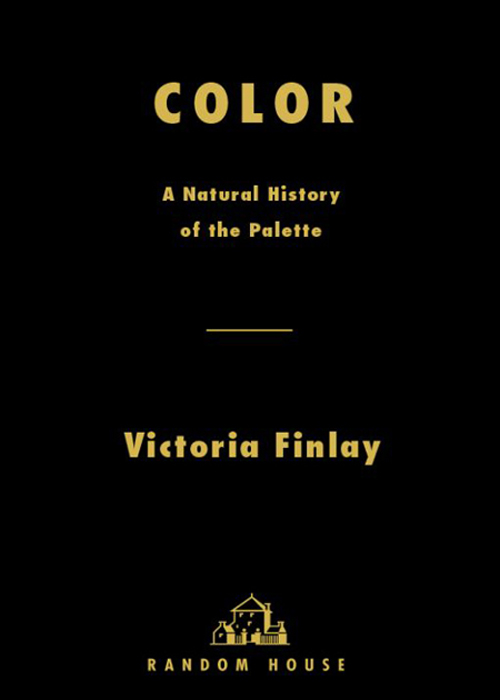
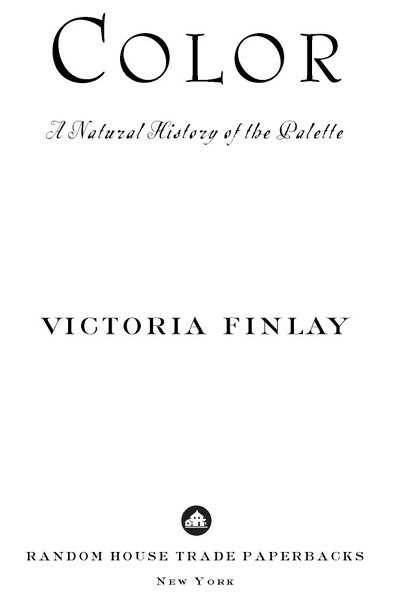
Table of Contents
For my parents, Jeannie and Patrick,
who first showed me the place where light dances
LOADED WITH FASCINATING TIDBITS. Boston Herald
A rainbow of stories... Even casual natural history fans can enjoy Finlays conversational style and her enthusiasm for her little-understood topic. Chicago Tribune
Color is the essence of landscape, of mood, of our whole perception of the physical world. Victoria Finlay has traveled through Iran, Afghanistan, and other places to investigate the origin of all those tantalizingly sensual ochers and reds and blues. What a creative idea for a book!ROBERT D. KAPLAN, author of The Ends of the Earth and Eastward to Tartary
A model of erudition and charm, the writing elegant and precise. SIMON WINCHESTER
Exhilarating... Finlays wide-ranging, richly detailed, and bravely researched survey of the colors of the palette leaves few stonesbe they lapis, malachite, or ochreunturned.... Youll never look at a box of Crayolas the same way.Book Street USA
Part travelogue, part history lesson, and part science seminar, Color takes us to remote parts of the world.... An inspired concept, Finlay shows the rich history behind what most of us take for granted. SOMA: Left Coast Culture
Packed with facts, fables, and anecdotes about the history of color, Finlays detailed and brilliantly researched account makes for a fascinating read. Australian Interior Trends
Compelling... Curious social mores, serendipitous science, and lots of skullduggery are all part of the rich spectrum Finlay so cheerfully illuminates. Booklist
ACKNOWLEDGMENTS
I had thought, when I set out on my travelswhen I first tumbled through that paintboxthat I would somehow find, in the original stories of colors, something pure. It was a nave Garden of Eden moment, and of course I forgot about the rainbow serpent that had to be there in order to make it a real paradise. In the historical and chemical paintbox I have found more corruption, poisonings, wars and politics than even the Medicis could have appreciated. Killer wallpapers, capital punishment for people using the wrong dyes, and beautiful blue stones which murder the lungs of those who find them underground: these have all featured in my travels. But in the process of uncovering them I have also found more wonderful and helpful people than I could have ever hoped. I can only thank some of them here.
For the Ochre chapter I should like to thank: the Australian Consulate General in Hong Kong, who awarded me an arts fellowship in 1999; everyone at Beswick including Alan Bunton who took me fishing and the Popple family who looked after me on the night I was homeless; Sean Arnold of Animal Tracks; Nina Bove; Malcolm Jagamarra; Roqu Lee; Dave and Patsy at the Buffalo farm in Kakadu; Allan Marett; Ken Methven; Hettie Perkins; Simon Turner. And a particular thank you to Geoffrey and Dorn Bardon, who were generous with both their information and their friendship.
For the Black and White chapters I should like to thank: Aidan Hart; Ann Coate; Susan Whitfield at the Dunhuang project; the Seniwati Gallery for Womens Art in Bali; Michael Skalka for a happy day discussing Rembrandts palette and many other things; Norman Weiss; everyone who helped me at Farrow & Ball; Ralph Boydell, Phil Harland, and everyone who helped me at Spode.
For my Red research I should particularly like to thank: Colores de Chile; Joyce Townsend at the Tate who also helped on many other paint history questions; and Dino Mahoney, Simon Wu and Barry Lowe who travelled with me on that underground train in Santiago.
For the Orange chapter I should like to thank: Peter and Charles Beare; Ricardo Bergonzi; Harald Boehmer; Ian Dejardin and Amy Dickson at Dulwich Picture Gallery; Michael Noone; Sandra Wagstaff; Maxim Vengerov; Mary Cahill and Gamini Abeysekera at UNICEF.
For Yellow, I am grateful to: Ana Alimardani; Fong So and Yeung Wai-man; Ian Garret at Winsor & Newton; Ebrahim Mukhtari; Tom and Emma Prentice for help in Saffron Walden; Mohammed Reza; Brian Lisus; Ellen Szita who appears for only a moment in the book, but our e-mail friendship has been stimulating and saffron-filled; Mahsoud and Nazanin and their family in Torbat; the Shariati family including Mrs. Shariati who provided a saffron feast to remember forever.
For help in the Green chapter, I thank: Chris Cooksey; Caroline Dalton at New College in Oxford; Michael Rogers at the School of Oriental and African Studies in London; Dawn Rooney; Rosemary Scott; Peter Zhao who translated through all the Famen celadon mysteries.
For my first Blue adventure in Afghanistan I am grateful to Jacquetta Hayes, who first invited me to cross the Khyber Pass; to Eric Donelli and Davide Giglio for their hospitality; Abdul Saboor Ulfat and his family and to Luc and everyone at Solidarit in Bamiyan for their help and their picnics at turquoise lakes. For my second journey I thank Gary Bowersox; Letizia Rossano; Atif Rizvi; Antonio Donini of UNOCHA for letting me on that plane to Faizabad; Mervyn Paterson and Khalid Mustafawi for looking after me when I arrived, Bob Nickelsberg, Tony Davis, Abdullah Buharistani, Yaqoub Khan and all the people at Sar-e-sang and elsewhere who shared what they had, even when they had almost nothing. Also thanks to Louise Govier and her colleagues at the National Gallery in London.
For Indigo I should like to thank: Jenny Balfour-Paul and her husband Glencairn for patiently checking and rechecking; Giacomo Chiari; Debbie Crum; John Edmonds for all his advice on both woad and purple; Pat Fish; Munirenkatappa Sanjappa at the Calcutta Botanical Gardens; John Stoker; Lionel Titchener.
For my search for Violet, I am grateful to: Santiago de la Cruz; Zvi Koren; and Nell Nelson who ensured that the quest to find purple in Mexico featured almost as many margaritas as snails.
And in addition I should like to thank: Genevieve Fox and Richard McClure for their hospitality on my numerous research visits to London; Donald Francis; Valerie Garrett for guidance on how to write a book proposal when all this was just a colorful fantasy; Eric Hilaire for his generous photo research; James Hodge; Don Jusko for an afternoon in Maui discussing pigments; Ted Katsargiris for asking people all over Cambodia about a mysterious yellow resin; Charles Anderson for reminding me how much I love libraries; NicholasWalt at Cornelissens in Great Russell Street, the most atmospheric artists shop in England; Dominic Lam; Peter Lucas at the University of Hong Kong; Steve McCarty; Alison Nadel; Wing, my travel agent, for never shirking questions like Whats the cheapest route to Tehran? And can I go via Manchester?; Martha Olo-an for looking after my home and animals so many times when I was away while if the world was fair she should have been with her own family in the Philippines; Hilary Goddard; Irene Nicholls for listening so patiently to all my draft chapters; Patrick Wolff; Ellen Pinto and Lawrence Herbert at Pantone; Martin Collins for solving my map crisis so quickly; Simon Trewin and Sarah Ballard at pfd for helping turn an idea into a book contract; Helen Garnon-Williams at Sceptre in London for helping making it into a better book; Dan Smetanka at Ballantine for his enthusiastic support from the very beginning and for champagne in Bryant Park; Emma Pearce, Joan Joyce and Sarah Miller at Winsor & Newton for their help and their pictures; the staff at the University of Hong Kong Library, the New York Public Library, the Indian National Library in Calcutta, the Library of Congress, the Post Office Archives, the Library of Mount Vernon. And most of all the wonderful British Library in London which became my second home. And finally Martin Palmer, without whom this book would have been written much more quickly, but with far less joy.
Next page

